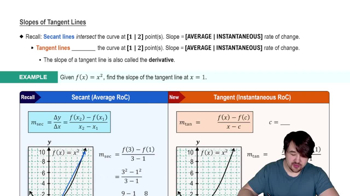Table of contents
- 0. Functions7h 52m
- Introduction to Functions16m
- Piecewise Functions10m
- Properties of Functions9m
- Common Functions1h 8m
- Transformations5m
- Combining Functions27m
- Exponent rules32m
- Exponential Functions28m
- Logarithmic Functions24m
- Properties of Logarithms34m
- Exponential & Logarithmic Equations35m
- Introduction to Trigonometric Functions38m
- Graphs of Trigonometric Functions44m
- Trigonometric Identities47m
- Inverse Trigonometric Functions48m
- 1. Limits and Continuity2h 2m
- 2. Intro to Derivatives1h 33m
- 3. Techniques of Differentiation3h 18m
- 4. Applications of Derivatives2h 38m
- 5. Graphical Applications of Derivatives6h 2m
- 6. Derivatives of Inverse, Exponential, & Logarithmic Functions2h 37m
- 7. Antiderivatives & Indefinite Integrals1h 26m
- 8. Definite Integrals4h 44m
- 9. Graphical Applications of Integrals2h 27m
- 10. Physics Applications of Integrals 2h 22m
6. Derivatives of Inverse, Exponential, & Logarithmic Functions
Derivatives of Inverse Trigonometric Functions
Problem 3.10.65c
Textbook Question
62–65. {Use of Tech} Graphing f and f'
c. Verify that the zeros of f' correspond to points at which f has a horizontal tangent line.
f(x)=e^−x tan^−1 x on [0,∞)
 Verified step by step guidance
Verified step by step guidance1
Step 1: Understand the problem. We need to graph the function f(x) = e^(-x) * tan^(-1)(x) and its derivative f'(x) over the interval [0, ∞). We will verify that the zeros of f'(x) correspond to points where f(x) has a horizontal tangent line.
Step 2: Find the derivative f'(x). Use the product rule for differentiation, which states that if you have a function h(x) = u(x) * v(x), then h'(x) = u'(x) * v(x) + u(x) * v'(x). Here, u(x) = e^(-x) and v(x) = tan^(-1)(x).
Step 3: Differentiate u(x) and v(x) separately. The derivative of u(x) = e^(-x) is u'(x) = -e^(-x). The derivative of v(x) = tan^(-1)(x) is v'(x) = 1/(1 + x^2).
Step 4: Apply the product rule. Substitute u(x), u'(x), v(x), and v'(x) into the product rule formula to find f'(x). This gives f'(x) = -e^(-x) * tan^(-1)(x) + e^(-x) * (1/(1 + x^2)).
Step 5: Graph f(x) and f'(x) using a graphing tool. Identify the zeros of f'(x) on the graph. These zeros are the x-values where f'(x) = 0, indicating that f(x) has a horizontal tangent line at these points. Verify that these correspond to the horizontal tangents on the graph of f(x).
 Verified video answer for a similar problem:
Verified video answer for a similar problem:This video solution was recommended by our tutors as helpful for the problem above
Video duration:
7mPlay a video:
Was this helpful?
Key Concepts
Here are the essential concepts you must grasp in order to answer the question correctly.
Derivative and Critical Points
The derivative of a function, denoted as f', represents the rate of change of the function f. Critical points occur where the derivative is zero or undefined, indicating potential local maxima, minima, or points of inflection. In this context, finding the zeros of f' helps identify where the function f has horizontal tangent lines, which are essential for understanding the function's behavior.
Recommended video:

Critical Points
Horizontal Tangent Lines
A horizontal tangent line occurs at points on the graph of a function where the slope is zero, meaning the derivative f' equals zero. This indicates that the function is neither increasing nor decreasing at that point, which is crucial for identifying local extrema. Verifying that the zeros of f' correspond to horizontal tangents helps confirm the relationship between the derivative and the function's graphical behavior.
Recommended video:

Slopes of Tangent Lines
Graphing Functions
Graphing a function involves plotting its values on a coordinate system to visualize its behavior. For the function f(x) = e^(-x) tan^(-1)(x), understanding its graph helps in analyzing its critical points and the nature of its tangent lines. Technology can assist in graphing to easily identify where the function has horizontal tangents, enhancing comprehension of the relationship between f and f'.
Recommended video:

Graph of Sine and Cosine Function

 7:26m
7:26mWatch next
Master Derivatives of Inverse Sine & Inverse Cosine with a bite sized video explanation from Callie
Start learning



